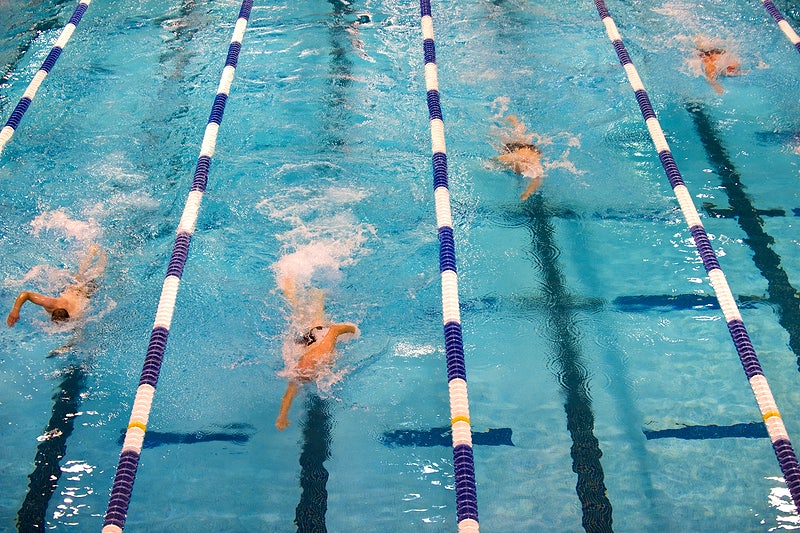New State of the Game
When it comes to sports, going for gold should be genderless. Competitive swimmers / Public Domain CC
Competitive swimmers / Public Domain CC
In 1902, British skater Madge Syers became the first woman to compete at the World Figure Skating Championships. At the time, there were no rules against women entering. Syers came in second to Swedish phenom Ulrich Salchow, for whom the foundational jump is named, and Salchow was so taken with Syers’ skill that he presented her with the gold medal during the ceremony. The International Skating Union (ISU) brought the subject of women competing against men to its 1903 congress, where the nine members raised several concerns. One was that the long skirts women wore while skating prevented the judges from seeing their feet. (In response, Syers pioneered the trend of wearing calf-length skirts on the ice to give the judges a better view of her footwork.) Others included the possibility of a male judge having to gauge the performance of a skater he might be romantically involved with, and the “difficulty” that women competing with men might encounter—never mind that Syers had beaten most of the men she’d faced.
Ultimately, the ISU voted 6 to 3 to close the competition to women. The Women’s Skating Championship began in 1906, and Syers won that competition the first two years it existed. She also won the gold medal at the 1908 Olympics, the first games to feature figure skating. By medaling, Syers solidified her reputation as a world-class athlete—and a threat to the traditional, male-dominated institution of competitive sports. Thanks to sexism, men consider comparisons to a woman to be an insult to their masculinity. But it’s even more than that, says Laura Pappano, co-author of the 2007 book Playing With the Boys: Why Separate Is Not Equal in Sports. Women who beat men are “not just a threat to men, but a threat to the social order and a threat to the man’s hierarchy in the social order,” she says.
With questions still swirling about gender equity in sports, such as transgender inclusion and where non-binary athletes fit, it’s worth asking how we ended up with sex-segregated sports in the first place. While it might appear to be “common sense” to organize sports into binary sex categories, people have been asking questions about the best ways to organize sports for more than a century—and the answer wasn’t always the one we’ve settled on today.
Olympic trapshooting was mixed-gender until 1992, when, for the first time ever, a woman won the competition at the Barcelona Games. Chinese shooter Zhang Shan tied the world record (and broke the Olympic record) by hitting 200 straight shots. After that, the International Shooting Sport Federation segregated the sport by sex and didn’t institute a trapshooting competition for women until 2000, forcing Zhang to prematurely retire from the sport.
“Sport has always been a way of enforcing social norms,” Pappano says. “And when those social norms are disrupted by play, it makes people uncomfortable.”
We’re now seeing this threat applied to transgender women, who are mostly allowed to play sports against cisgender women until they have some degree of success. Once trans women begin to win, they often face pushback, stricter regulations, and body policing because they’re now perceived to be a threat to the status quo. “For some reason, people really cling to that sex-segregated system,” says Lindsay Pieper, associate professor of sport management at the University of Lynchburg. “People get really angsty when you think about possible new structures for sport.”
Legally, however, boys attempting to gain the right to play on girls-only teams have not been as successful.
What actually codified sex-segregated sports was Title IX, the legislation long touted as a progressive step for women’s sports. The legislation itself doesn’t actually mention athletics. Instead, it was designed to address women’s entry into educational institutions as students, scholarship recipients, and faculty—which is why it only applies to educational institutions receiving federal funds.
Organizations like the NCAA fought to limit Title IX’s application to sports, fearing it would jeopardize their men’s sports programs (i.e., income streams). Meanwhile, women’s rights groups were asking legislators to consider every angle before applying Title IX to athletics. “NOW is opposed to any regulation which precludes eventual integration,” the National Organization for Women wrote in 1974. “Regulations that ‘protect’ girls and/or women are against NOW goals and are contradictory to our stand on the [Equal Rights Amendment].”
Both the Supreme Court’s 1954 Brown v. Board of Education ruling, striking down “separate but equal,” and the Civil Rights Act of 1964 informed reactions to the passage of Title IX in 1972. Groups like NOW had a long-term vision for a co-ed or integrated system, which would have been easier to implement because it required a single division for each sport, as opposed to creating separate divisions and facilities for each sex. But because Title IX formed its protections on the basis of a sexual binary, all federal legislation based on Title IX had to adopt this binary structure as the primary way to organize federally funded activities, including public sports. In doing so, Title IX not only failed to challenge assumptions of girls’ athletic inferiority, but the legislation actually reinforced it by codifying separate divisions that further entrenched the idea.
“I think we need to take a hard look at the messages that we send when we create restrictions, especially at the school and recreational level,” Pappano says. While Title IX itself permits sex-segregated sports, the courts have overwhelmingly suggested that the equal protection clause in the U.S. Constitution does not. In all five prominent cases in which girls have sued for the right to try out for a boys’ football team, courts have ruled that they must be permitted. In one case, the court said that classifications must not reflect “archaic and stereotypic notions” about sex differences.
Legally, however, boys attempting to gain the right to play on girls-only teams have not been as successful. Courts have decided that since Congress intended Title IX to be a remedy for historical discrimination against women, individual boys could be denied the right to play on girls’ teams. The asymmetry of athletic opportunities offered to men and women is what legal scholar Jamal Greene refers to as the best justification for the “one-way ratchet that allows women to participate in male-only sports without extending the same opportunity to males who wish to participate in female-only sports.”
But for all the social reasons that coercive sex segregation is an unfair way to organize sports, there are more serious issues at play. Sex isn’t actually a binary, which remains the most obvious reason why sports shouldn’t be organized by binary gender categories. People aren’t neatly organized into “male” and “female”—intersex, nonbinary, and transgender people exist and are always going to present a challenge to any system that insists on separating people into two gender categories. “[Many things have] a biological range, and we’re trying to create this dichotomy that’s very sharp,” Pappano says. “Michael Phelps has a really long wingspan and really long feet that allegedly operate [like] flippers. And yet, we’re not saying [if] your feet are bigger than this, you can’t compete. We’re creating a set of parameters that, if we were to step back, don’t make sense, may not be fair, and I think can be hurtful to the people who play.”
If people could choose which category they felt safest competing in, perhaps coercive sex segregation wouldn’t be as traumatic as it is for those who fall outside of binary sex categories. When, toward the end of high school, Connor transferred to an elite girls’ hockey team to try to have a better chance of getting a college scholarship, they “had a terrible time of it.” There was an assumption that the team environment would be better for Connor because they were finally going to be on a team of girls, but that wasn’t the case. “All I could think was, ‘I am not like you at all,’” they recall. In short order, they switched back to the boys’ team—and were still able to get a scholarship to play Division I girls’ hockey.
The current push by anti-trans groups to weaponize Title IX to exclude trans girls from girls’ athletics is “such a misrepresentation” of the legislation, says Pieper. The Biden administration has affirmed that Title IX protects LGBTQ students, which includes transgender athletes. “Transgender youth should be able to play with people based on their joy of movement and athletic interest and ability and not feel this pressure based on social norms,” says Pappano.
Both Connor and Hovda agree that the environment for young trans athletes today is particularly hostile, given the spate of legislation in states around the country targeting trans people’s medical care, public accommodations, and athletic participation. “If I were 15 now and trying to play sports, I would have thrown in the towel,” says Connor. Hovda agrees: “With how things are now I would rather just not do sports.”
This sex-segregated system would be less of an issue if the sex categories in athletics weren’t so heavily policed. Sports participation at the collegiate and professional levels is often regulated by testosterone levels, and bills are being passed across the U.S. that would subject students suspected of being trans to intrusive body and genital exams.
“Sports officials are trying to uphold this false binary and keep turning to medical and scientific practices to do so,” says Pieper, who wrote the 2016 book Sex Testing: Gender Policing in Women’s Sports. “And every time, it’s being shown that that’s not a way you can divide people because people can’t be divided neatly into just two categories.” And yet, Pappano says, “Sports are only becoming more entrenched” in the gender binary.
If people could choose which category they felt safest competing in, perhaps coercive sex segregation wouldn’t be as traumatic as it is for those who fall outside of binary sex categories.
There are plenty of reasons to integrate sports: Boys can learn to respect and befriend the girls on their team, while girls can access the same social benefits as their male counterparts. Inclusion also chips away at the overarching narrative that women’s and girls’ sports are second tier, and therefore women and girls, as athletes, are inferior to men. And yet, it’s often an uphill battle for girls who play on boys’ teams. Some are harassed to the point that they’re forced to drop out, while others persist even when it takes a negative toll on their self-confidence or mental health. “So much of sports is psychological,” Pappano says. “How do you play when you are constantly told that you don’t belong somewhere, that you shouldn’t be there? It’s a psychological burden.”
That burden was intensified for Alexa van Sickle, 38, who played baseball as a child. When she joined her team at age 9 or 10, she was assumed to be a boy on the first day and she never corrected her coaches or teammates. “The impact of hiding was the concern of being found out, for my gender to be any factor at all in my experiences with the team,” she says. “I don’t remember it as a negative experience, but it also fundamentally sucks that I felt I had to.”
In sports like baseball, where there’s no infrastructure for girls’ baseball past high school, girl players may receive less investment and development from their coaches because they’re seen as having no future in the sport. As a result, girls—especially those playing sports that don’t have women’s collegiate or professional teams to aspire to—must constantly prove that they deserve to be on the team. “I had to be so good that the coaches would want me to play,” Connor says. “I wanted to keep playing on the boys’ teams, and [being the best] was the way to do it, and that was how I did it.”
If people could choose which category they felt safest competing in, perhaps coercive sex segregation wouldn’t be as traumatic as it is for those who fall outside of binary sex categories. When, toward the end of high school, Connor transferred to an elite girls’ hockey team to try to have a better chance of getting a college scholarship, they “had a terrible time of it.” There was an assumption that the team environment would be better for Connor because they were finally going to be on a team of girls, but that wasn’t the case. “All I could think was, ‘I am not like you at all,’” they recall. In short order, they switched back to the boys’ team—and were still able to get a scholarship to play Division I girls’ hockey.
The current push by anti-trans groups to weaponize Title IX to exclude trans girls from girls’ athletics is “such a misrepresentation” of the legislation, says Pieper. The Biden administration has affirmed that Title IX protects LGBTQ students, which includes transgender athletes. “Transgender youth should be able to play with people based on their joy of movement and athletic interest and ability and not feel this pressure based on social norms,” says Pappano.
Both Connor and Hovda agree that the environment for young trans athletes today is particularly hostile, given the spate of legislation in states around the country targeting trans people’s medical care, public accommodations, and athletic participation. “If I were 15 now and trying to play sports, I would have thrown in the towel,” says Connor. Hovda agrees: “With how things are now I would rather just not do sports.”
This sex-segregated system would be less of an issue if the sex categories in athletics weren’t so heavily policed. Sports participation at the collegiate and professional levels is often regulated by testosterone levels, and bills are being passed across the U.S. that would subject students suspected of being trans to intrusive body and genital exams.
“Sports officials are trying to uphold this false binary and keep turning to medical and scientific practices to do so,” says Pieper, who wrote the 2016 book Sex Testing: Gender Policing in Women’s Sports. “And every time, it’s being shown that that’s not a way you can divide people because people can’t be divided neatly into just two categories.” And yet, Pappano says, “Sports are only becoming more entrenched” in the gender binary.
Until society is ready to have complicated conversations about gender, it’s going to be difficult to integrate sports.
There are plenty of reasons to integrate sports: Boys can learn to respect and befriend the girls on their team, while girls can access the same social benefits as their male counterparts. Inclusion also chips away at the overarching narrative that women’s and girls’ sports are second tier, and therefore women and girls, as athletes, are inferior to men. And yet, it’s often an uphill battle for girls who play on boys’ teams. Some are harassed to the point that they’re forced to drop out, while others persist even when it takes a negative toll on their self-confidence or mental health. “So much of sports is psychological,” Pappano says. “How do you play when you are constantly told that you don’t belong somewhere, that you shouldn’t be there? It’s a psychological burden.”
That burden was intensified for Alexa van Sickle, 38, who played baseball as a child. When she joined her team at age 9 or 10, she was assumed to be a boy on the first day and she never corrected her coaches or teammates. “The impact of hiding was the concern of being found out, for my gender to be any factor at all in my experiences with the team,” she says. “I don’t remember it as a negative experience, but it also fundamentally sucks that I felt I had to.”
In sports like baseball, where there’s no infrastructure for girls’ baseball past high school, girl players may receive less investment and development from their coaches because they’re seen as having no future in the sport. As a result, girls—especially those playing sports that don’t have women’s collegiate or professional teams to aspire to—must constantly prove that they deserve to be on the team. “I had to be so good that the coaches would want me to play,” Connor says. “I wanted to keep playing on the boys’ teams, and [being the best] was the way to do it, and that was how I did it.”
Prior to Title IX, physical education was sex-segregated. Victoria Jackson, clinical assistant professor of history at Arizona State University, sees that as a model for moving forward. “That, I think, is where we really saw the potential transformative power of Title IX in a school setting,” Jackson says. “I do think a lot of young people, because [physical education] has been desegregated, they grow up playing with everyone, and you learn a lot about yourself and about others when you’re playing sports with everyone.”
Some club-level sports, like quadball (formerly quidditch) and Ultimate, are already integrating their divisions to allow athletes to self-select where they compete. And, at the youth level, many sports are co-ed until the kids hit puberty. Some people, like law professor Nancy Leong, have suggested organizing sports based on things like height or weight class, rather than gender. Ultimately, however, until society is ready to have complicated conversations about gender, it’s going to be difficult to integrate sports.
“It may be a while before we get to the most elite competition at the highest levels, but let’s start creating a new norm around playing together recreationally and at school levels,” says Pappano.
“There are all kinds of barriers to girls’ participation in ostensibly segregated sports,” says van Sickle. “Blending in with the boys was how I was used to doing things, but for other girls at that age, that might not be comfortable. I saw myself as equal and therefore I felt I was, and I’m sure that helped me on the field. But that’s not the message most girls internalize, and that starts at a young age.”
Hovda wonders what sports could have been like for her if they had been integrated when she was growing up. “If there’s a potential for it to be even slightly better with desegregated sports, it’s worth the fight,” she says. “It’s worth the conversation.”
Your support matters…Independent journalism is under threat and overshadowed by heavily funded mainstream media.
You can help level the playing field. Become a member.
Your tax-deductible contribution keeps us digging beneath the headlines to give you thought-provoking, investigative reporting and analysis that unearths what's really happening- without compromise.
Give today to support our courageous, independent journalists.






You need to be a supporter to comment.
There are currently no responses to this article.
Be the first to respond.